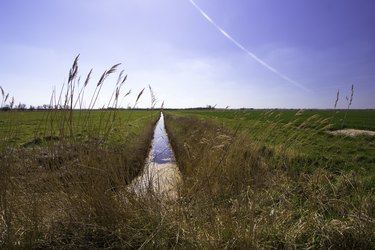
Open drainage ditches are an established, reliable and natural technique for draining and redirecting water that accumulates on roadsides and low-lying areas. When neglected, ditch erosion can occur, which is when the water carries the soil away. This erosion can make the surrounding soil less stable, and the ditch can get much larger. In the worst-case scenarios, ditches turn into sinkholes and cause significant damage.
How to Fix Erosion
Video of the Day
Shallow, wide ditches are also referred to as swales, and they are often created as suitable outlets for water flow. These channels can be lined with stones, and large ones can act as stabilizers. You will need to install a sturdy base down in the dirt first, though. To do so, you can place a tightly woven landscaping fabric and secure it on the edges. When choosing your stones, you'll want to pick larger ones if there are heavier water flows.
Video of the Day
Some people also succeed by planting more grass and vegetation on the banks and slopes of ditches, and inserting dormant wood cuttings into the ditch can also help. Another option is to line the ditch with a flexible RPE (reinforced polyethylene) liner. These are easy to handle, and they are lightweight and can last as long as 20 years. Regular plastic liners can work just as well, but the size options may be more limited; you might have to get more than one or dig out the ditch wider to accommodate those.
Other Ditch Erosion Control Methods
Poured concrete is also used for lining drainage and irrigation ditches and gets poured into the channels. These are pretty strong but can become stiff over time. As the soil beneath it shifts, tiny cracks can start to form, which in turn can cause small leaks that could later become much more significant. There are also preformed concrete liners that come in sections. However, these preformed liners are often significantly more expensive and heavy to transport. Additionally, they can develop leaks in their seams.
Polymer-based spray ditch liners are sometimes used with rock layers (this method is called rip rap), but these ditch liners tend to be limited-use ditch fixes. The sprays are known to fail after short periods of time and do not work well with the rock layers. These ditch liners tend to be used only when there is limited availability of the other kinds of erosion control methods.
How to Fill a Ditch
Ditches often need to be filled when they are eyesores or no longer serve their original purposes. You won't want to just pour in the dirt, though, as that could lead to significant flooding. Line the entire bottom with gravel first and then put drainage tile (also called plastic perforated pipe) in the bottom. These are about 4 inches long, so you may have to use more than one and connect them with couplings.
One end of the pipe should be at the edge of the ditch and cover the opening with mesh to prevent debris and small animals from getting inside. Then, you can fill the ditch with more gravel, up to within 4 inches of the top and edges. Cover that with the same amount of sand and then seed the area with grass that can thrive in this soil. Once the ditch is filled, you can turn it into a landscaping feature by building a wooden bridge over it, building a rock garden nearby or adding some new plants and shrubs along the sides.